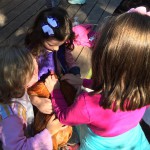ANNOUNCEMENT: Poplar Grove Foundation Inc. is pleased to announce its partnership with Moores Creek Battlefield to introduce 4th & 5th graders to Southeastern North Carolina’s role in the Revolutionary War in a joint program to visit both sites!
The Open OutDoors for Kids grant covers the program fees and transportation costs. The National Park Foundation provides learning opportunities for students to explore local history: “Building on a child’s innate wonder and curiosity about the natural world, Open OutDoors for Kids connects students to their national parks through field trips, classroom engagements, and educational activities.”
The 250th anniversary of the founding of this Nation is only two years away, and we have been working with Moores Creek Battlefield to draw attention to North Carolina’s Revolutionary War history: National Park Service and America 250 Launch Countdown to 250th Anniversary Commemoration of American Independence – Office of Communications (U.S. National Park Service) (nps.gov)
For teachers interested in this unique opportunity, we suggest reaching out first through Moores Creek National Battlefield by visiting: Education – Moores Creek National Battlefield (U.S. National Park Service) (nps.gov).
The staff at Poplar Grove is dedicated to helping students understand the uniqueness of life along the Gullah Geechee Cultural Heritage Corridor through several generations, including the operations and purposes of plantation life from enslavement to tenant farming.
Elementary and middle school educational programs are designed to meet Competency Goals for the Common Core Social Studies & NC Essential Standards, most specifically for elementary-age groups.
For the safety of the faculty, staff, parents and students, school-sponsored activities are required to register by downloading the School Group Trip Request Form and emailing a copy to Caroline Lewis at caroline@poplargrove.org.
Upper middle school and high school educational programs can be tailored to meet the goals of a specific unit, or a particular area of interest or subject matter to be more in-depth and challenging to include the harsh realities of enslavement, tenant farming, Jim Crow, and the 1898 Wilmington Race Massacre.
Once registered, a packet of information will be emailed one week prior to your visit.
THINGS TO SEE & DO
- Orientation
- This overview will start the visit with a map and schedule of your class activities.
- Manor House
- C. 1850. The original manor house, belonging to Cornelius Harnett circa 1767, was closer to Futch Creek. By 1850, Joseph Mumford Foy purchased plans to build a new house closer to the Wilmington-New Bern Plank Road. Overseeing the home’s construction, enslaved males sourced materials on site, including digging for clay deposits and building kilns for brick masonry, harvesting timbers for framing, heart pine for flooring, black walnut for the main staircase, and plasterwork from tabby to plaster of Paris. Such engineering skills were also supplemented by renting enslaved artisans males from nearby plantations.
- Smoke House
- C. 1850. Used for smoking meat, a form of food preservation during a time when there was no refrigeration, to include beef, pork, wild game, and fish. Using sea salt cultivated from the sound, West African traditions of salt production trace its origins to trans-Saharan trade routes.
- While smoking meats today is used primarily for flavor, in a time period before refrigerators, it was a key form of preserving foods. Smoking meats and fish was particularly important during the winter season when fruits and vegetables were scarce.
- Kitchen Storage House & Herb Cellar
- C. 1850. Cooking was done in a separate building, away from the manor house, due to the threat of fire. The original kitchen, which no longer exists, was a clapboard rectangular structure that had a center chimney with three hearths (beehive chimney) located where the current windmill stands.
- The Herb Cellar is the underground level of the Kitchen Storage House. It was used to dry and store herbs from the garden for flavoring dishes, preparing medicinal remedies, and dying fabrics in colors such as indigo, saffron, black walnut and cochineal.
- Tenant House
- C. 1875. Tenant farming became the new form of enslavement after the Civil War. At Poplar Grove, more than 2/3 of the formerly enslaved remained on site, and a few family descendants remained on site as tenant farmers and domestic servants through WWI and WWII. Until the 1960s, this two-room tenant house was last occupied by Nimrod Nixon, descended through several generations of the Gullah peoples.
- Gardens (in season)
- Display gardens on site include herbs, vegetables and flowers, dye plants, peanuts, tobacco and cotton at various times of the year.
- Peanut & Agricultural Exhibit Building
- Housing a collection of antique farming tools, equipment used around the early 1900’s for peanut production and harvesting, plus exhibits on peanut production.
- Basket Studio
- A large variety of baskets, materials and techniques are used here to interpret the skill and history of basketry.
- Blacksmith Shop
- Traditions in metallurgy dates as far back as 5000 BCE in Egypt, known as the Copper Age, followed by the Bronze Age, followed by the Iron Age. Africans began smelting iron approximately 2,500 years ago, and the ability to create with iron, forging agricultural instruments (iron plows, sickles and hoes), musical instruments and weapons for fishing, hunting and warfare, was considered a divine skill; therefore, a skilled blacksmith was most highly valued on plantations and in villages and towns.
- The blacksmith also created and/or repaired nails, eating utensils, farm equipment, carriages, carts, wagons, working exclusively with enslaved wheelwrights, farriers, and coopers.
- Print Shop
- Learn the trade of printmaking and see how newspapers were printed before computers, typewriters, and even electricity!
- The Stables
 View a menagerie of goats, sheep, horses, ponies, geese, chickens, and more.
View a menagerie of goats, sheep, horses, ponies, geese, chickens, and more.-
Available on a first-come, first-serve basis, school groups are welcome to use the picnic tables for lunch and the playground for break-time. Restrooms on site as well as bus parking.

